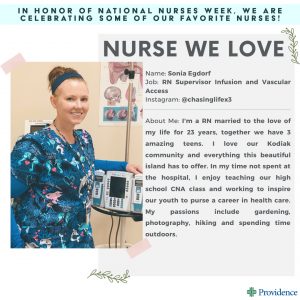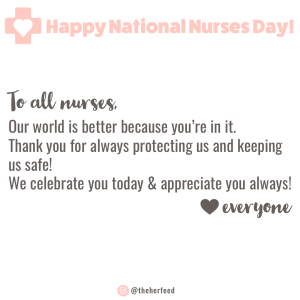Her Health Matters: Breast Cancer
- Health & Wellness
- Oct 13, 2019
October is Breast Cancer Awareness Month so we felt that it was important to dedicate this month’s HerHealthMatters to all things breast cancer and breast health. As a reminder, HerHealthMatters is a little bit of a play on words with a double meaning. It represents the importance of a woman’s health and the subject of topics this series covers (women’s health). We couldn’t do this alone (nor would I try) so we’ve partnered with Providence St. Joseph Health to provide us with the information, education and support for this weekly series.

I know so many women who have been impacted by this disease and I know that there are so many of y0u who have as well. According to http://breastcancer.org, as of January 2019, there are more than 3.1 million women with a history of breast cancer in the U.S. including women currently being treated and women who have finished treatment. That number is pretty astonishing when you think about it. However, the good news is that breast cancer diagnoses are decreasing with a lot of that being attributed to treatment advances, earlier detection through screening, and increased awareness. Our goal is to help educate and increase awareness to our readers so without further ado, here’s your “cheatsheet” on breast cancer.

WHAT IS BREAST CANCER?
The term “breast cancer” refers to a malignant tumor that has developed from cells in the breast. Doctors know that breast cancer occurs when some breast cells begin to grow abnormally. These cells divide more rapidly than healthy cells do and continue to accumulate, forming a lump or mass. Cells may spread (metastasize) through your breast to your lymph nodes or to other parts of your body.
Usually breast cancer begins either in the cells of the lobules (the milk-producing glands) or in the ducts (the passages that drain milk from the lobules to the nipple). Less commonly, breast cancer can begin in the stromal tissues, which include the fatty and fibrous connective tissues of the breast.
Researchers have identified hormonal, lifestyle and environmental factors that may increase your risk of breast cancer. But it’s not clear why some people who have no risk factors develop cancer, yet other people with risk factors never do. It’s likely that breast cancer is caused by a complex interaction of someone’s genetic makeup and environment.

BREAST CANCER STATISTICS
- About 5-10% of breast cancers can be linked to gene mutations inherited from one’s mother or father.
- A woman’s risk of breast cancer nearly doubles if she has a first-degree relative (mother, sister, daughter) who has been diagnosed with breast cancer.
- As of January 2019, there are more than 3.1 million women with a history of breast cancer in the U.S. This includes women currently being treated and women who have finished treatment.
- About 1 in 8 U.S. women (about 12%) will develop invasive breast cancer over the course of her lifetime.
- In 2019, an estimated 268,600 new cases of invasive breast cancer are expected to be diagnosed in women in the U.S., along with 62,930 new cases of non-invasive (in situ) breast cancer.
- 85-90% of breast cancers are due to gene abnormalities that happen as a result of the aging process and the “wear and tear” of life in general.
- About 2,670 new cases of invasive breast cancer are expected to be diagnosed in men in 2019. A man’s lifetime risk of breast cancer is about 1 in 883.

BREAST CANCER COMMON SYMPTOMS
Breast cancer symptoms can vary (from lumps to swelling) and many breast cancers have no obvious symptoms at all. In some instances, a lump may be too small to feel or see by the naked eye but shows up on a screening mammogram (x-ray of the breast) which leads to further testing. In other cases, the first sign of breast cancer is a new mass or lump that you or your doctor can feel.
The common symptoms of breast cancer are:
A breast lump or thickening that feels different from the surrounding tissue
- Change in the size, shape or appearance of a breast
- Changes to the skin over the breast, such as dimpling
- A newly inverted nipple
- Peeling, scaling, crusting or flaking of the pigmented area of skin surrounding the nipple (areola) or breast skin
- Redness or pitting of the skin over your breast, like the skin of an orange
- Breast pain
- Nipple discharge other than breast milk
- A lump or mass in the underarm area
** If you notice any breast changes, you should contact your doctor for an examination.

CAUSES: Changes or mutations in DNA can cause normal breast cells to become cancerous. These cancerous masses grow when a cell’s DNA is damaged, but why or how that DNA becomes damaged is still unknown. Doctors know that breast cancer occurs when some breast cells begin to grow abnormally. These cells divide more rapidly (and out of control) than healthy cells do and continue to accumulate, forming a lump or mass.
RISK FACTORS: It’s likely that breast cancer is caused by a complex interaction of your genetic makeup and your environment. Researchers have identified hormonal, lifestyle and environmental factors that may increase your risk of breast cancer. But it’s not clear why some people who have no risk factors develop cancer, yet other people with risk factors never do.
Some common risk factors that are associated with an increased risk of breast cancer include:
- Being female
- Increasing age
- A personal history of breast cancer or breast conditions
- Family history of breast cancer, or having genetic mutations related to certain types of breast cancer. Family history that includes having a first degree relative (mother, sister, daughter, father, brother, son) with breast cancer poses a higher risk for you. If you have more than one relative on either side of your family with breast cancer, you have a higher risk. In terms of genetic mutations, these include changes to genes like BRCA1 and BRCA2.
- Radiation exposure
- Obesity
- Beginning your period at a younger age
- Beginning menopause at an older age
- Having your first child at an older age
- Having never been pregnant
- Postmenopausal hormone therapy
- Drinking alcohol
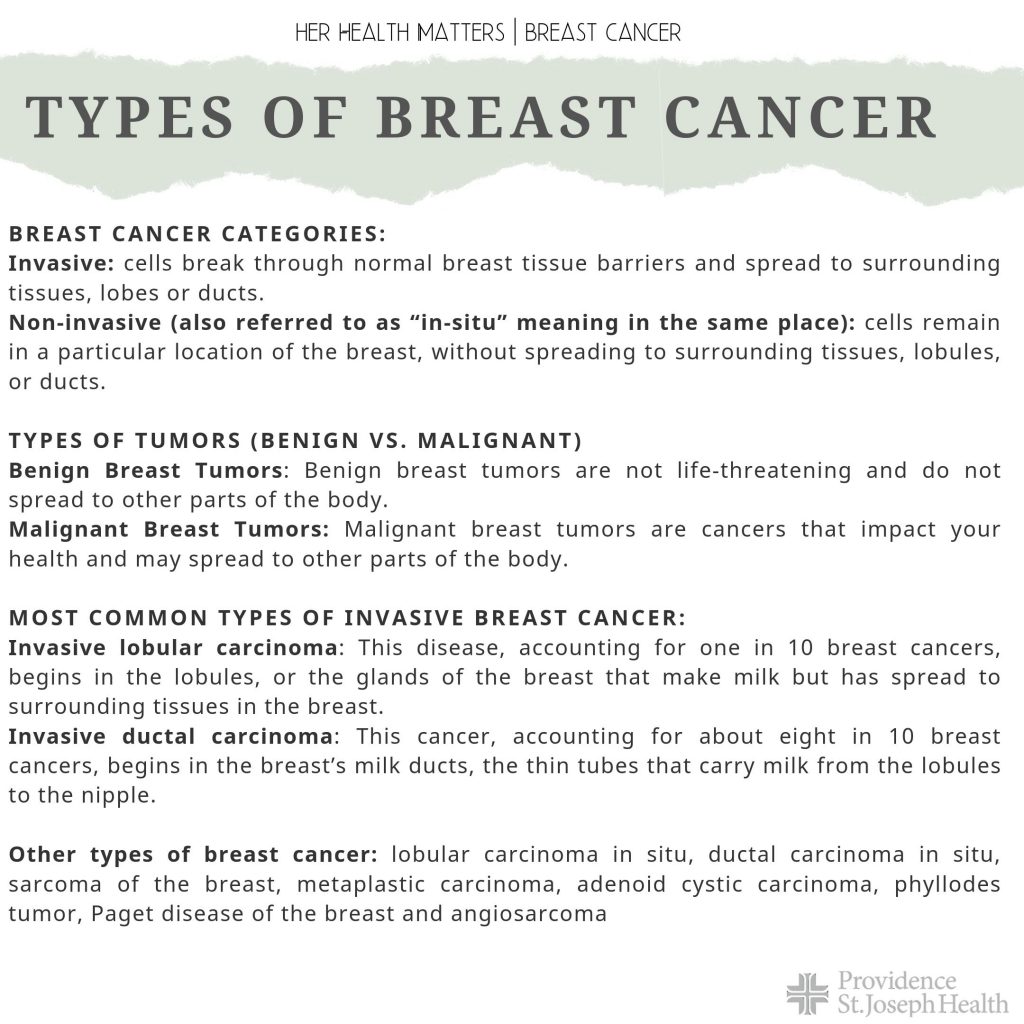
BREAST CANCER TYPES + CATEGORIES
Breast cancer categories:
Invasive: cells break through normal breast tissue barriers and spread to surrounding tissues, lobes or ducts.
Non-invasive (also referred to as “in-situ” meaning in the same place): cells remain in a particular location of the breast, without spreading to surrounding tissues, lobules, or ducts.
Types of Tumors (Benign vs. Malignant)
Benign Breast Tumors: Benign breast tumors are not life-threatening and do not spread to other parts of the body.
Malignant Breast Tumors: Malignant breast tumors are cancers that impact your health and may spread to other parts of the body.
MOST COMMON TYPES OF INVASIVE BREAST CANCER:
Invasive lobular carcinoma: This disease, accounting for one in 10 breast cancers, begins in the lobules, or the glands of the breast that make milk but has spread to surrounding tissues in the breast.
Invasive ductal carcinoma: This cancer, accounting for about eight in 10 breast cancers, begins in the breast’s milk ducts, the thin tubes that carry milk from the lobules to the nipple.
Other types of breast cancer: lobular carcinoma in situ, ductal carcinoma in situ, sarcoma of the breast, metaplastic carcinoma, adenoid cystic carcinoma, phyllodes tumor, Paget disease of the breast (also known as Paget’s disease) and angiosarcoma.
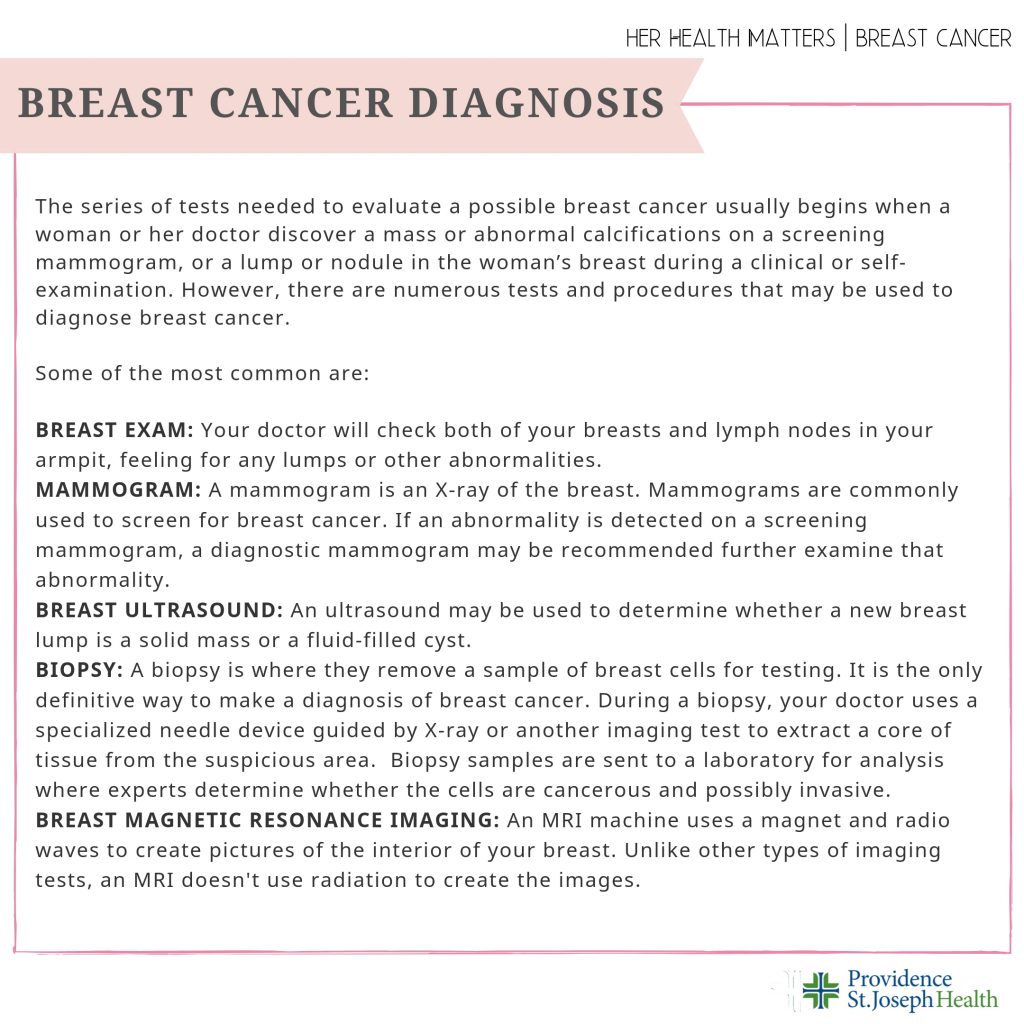
BREAST CANCER DIAGNOSIS:
The series of tests needed to evaluate a possible breast cancer usually begins when a woman or her doctor discover a mass or abnormal calcifications on a screening mammogram, or a lump or nodule in the woman’s breast during a clinical or self-examination. However, there are numerous tests and procedures that may be used to diagnose breast cancer.
Some of the most common are:
BREAST EXAM: Your doctor will check both of your breasts and lymph nodes in your armpit, feeling for any lumps or other abnormalities.
MAMMOGRAM: A mammogram is an X-ray of the breast. Mammograms are commonly used to screen for breast cancer. If an abnormality is detected on a screening mammogram, a diagnostic mammogram may be recommended further examine that abnormality.
BREAST ULTRASOUND: An ultrasound may be used to determine whether a new breast lump is a solid mass or a fluid-filled cyst.
BIOPSY: A biopsy is where they remove a sample of breast cells for testing. It is the only definitive way to make a diagnosis of breast cancer. During a biopsy, your doctor uses a specialized needle device guided by X-ray or another imaging test to extract a core of tissue from the suspicious area. Biopsy samples are sent to a laboratory for analysis where experts determine whether the cells are cancerous and possibly invasive.
BREAST MAGNETIC RESONANCE IMAGING: An MRI machine uses a magnet and radio waves to create pictures of the interior of your breast. Unlike other types of imaging tests, an MRI doesn’t use radiation to create the images.

STAGES OF BREAST CANCER:
Once breast cancer has been diagnosed, the patient’s doctor works to determine the extent (stage) of the cancer. Knowing the cancer stage will help your care team recommend a personalized treatment plan specific to your disease.
TNM RATING SYSTEM: The most common tool that doctors use to describe the stage of cancer and the results are combined to determine the stage of cancer for each person.. Doctors use the results from diagnostic tests and scans to answer these questions:
- Tumor (T): How large is the primary tumor? Where is it located?
- Node (N): Has the tumor spread to the lymph nodes? If so, where and how many?
- Metastasis (M): Has the cancer spread to other parts of the body? If so, where and how much?
Tests and procedures used to stage breast cancer may include: blood tests, such as a complete blood count, mammogram of the other breast to look for signs of cancer, breast MRI, bone scan, computerized tomography (CT) scan, positron emission tomography (PET) scan. Breast cancer staging also takes into account your cancer’s grade; the presence of tumor markers, such as receptors for estrogen, progesterone and HER2; and proliferation factors.
STAGES OF BREAST CANCER: Breast cancer diagnosed as stage I or stage II is considered an early stage, while stages III and IV are considered advanced.
STAGE O: Breast mass is noninvasive, and there is no indication that the tumor cells have spread to another part of the breast or other parts of the body. Difficult to detect can be found with breast self-exams.
STAGE I: Tumor measures up to 2 cm, and no lymph nodes are involved. Difficult to detect.
STAGE II: Known as invasive breast cancer and the tumor measures 2 cm and 5 cm, or cancer has spread to the lymph nodes under the arm on the same side as the breast cancer. Still has not spread to a distant part of the body.
STAGE III: Locally advanced breast cancer, the tumor is in the stage of breast cancer that is more than 2 inches in diameter across and the cancer is extensive in the underarm lymph nodes or has spread to other lymph nodes or tissues near the breast.
STAGE IV: Known as metastatic breast cancer, cancer in this stage has spread beyond the breast, underarm, and internal mammary lymph nodes to other parts of the body near or distant from the breast.
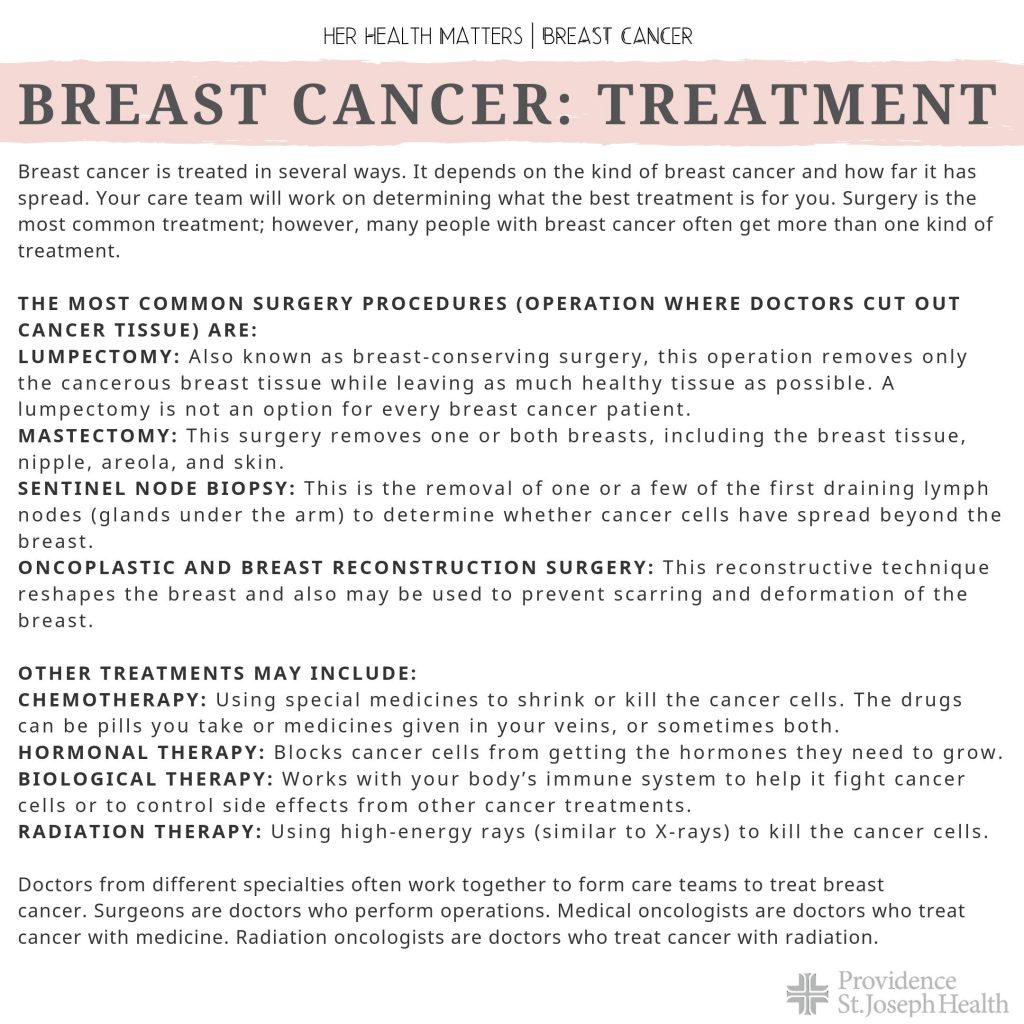
BREAST CANCER TREATMENT:
Breast cancer is treated in several ways. It depends on the kind of breast cancer and how far it has spread. Your care team will work on determining what the best treatment is for you. Surgery is the most common treatment; however, many people with breast cancer often get more than one kind of treatment.
The most common surgery procedures (operation where doctors cut out cancer tissue) are:
LUMPECTOMY: Also known as breast-conserving surgery, this operation removes only the cancerous breast tissue while leaving as much healthy tissue as possible. A lumpectomy is not an option for every breast cancer patient.
MASTECTOMY: This surgery removes one or both breasts, including the breast tissue, nipple, areola, and skin.
SENTINEL NODE BIOPSY: This is the removal of one or a few of the first draining lymph nodes (glands under the arm) to determine whether cancer cells have spread beyond the breast.
ONCOPLASTIC AND BREAST RECONSTRUCTION SURGERY: This reconstructive technique reshapes the breast and also may be used to prevent scarring and deformation of the breast.
OTHER TREATMENTS MAY INCLUDE:
CHEMOTHERAPY: Using special medicines to shrink or kill the cancer cells. The drugs can be pills you take or medicines given in your veins, or sometimes both.
HORMONAL THERAPY: Blocks cancer cells from getting the hormones they need to grow.
BIOLOGICAL THERAPY: Works with your body’s immune system to help it fight cancer cells or to control side effects from other cancer treatments.
RADIATION THERAPY: Using high-energy rays (similar to X-rays) to kill the cancer cells.
Doctors from different specialties often work together to form care teams to treat breast cancer. Surgeons are doctors who perform operations. Medical oncologists are doctors who treat cancer with medicine. Radiation oncologists are doctors who treat cancer with radiation.
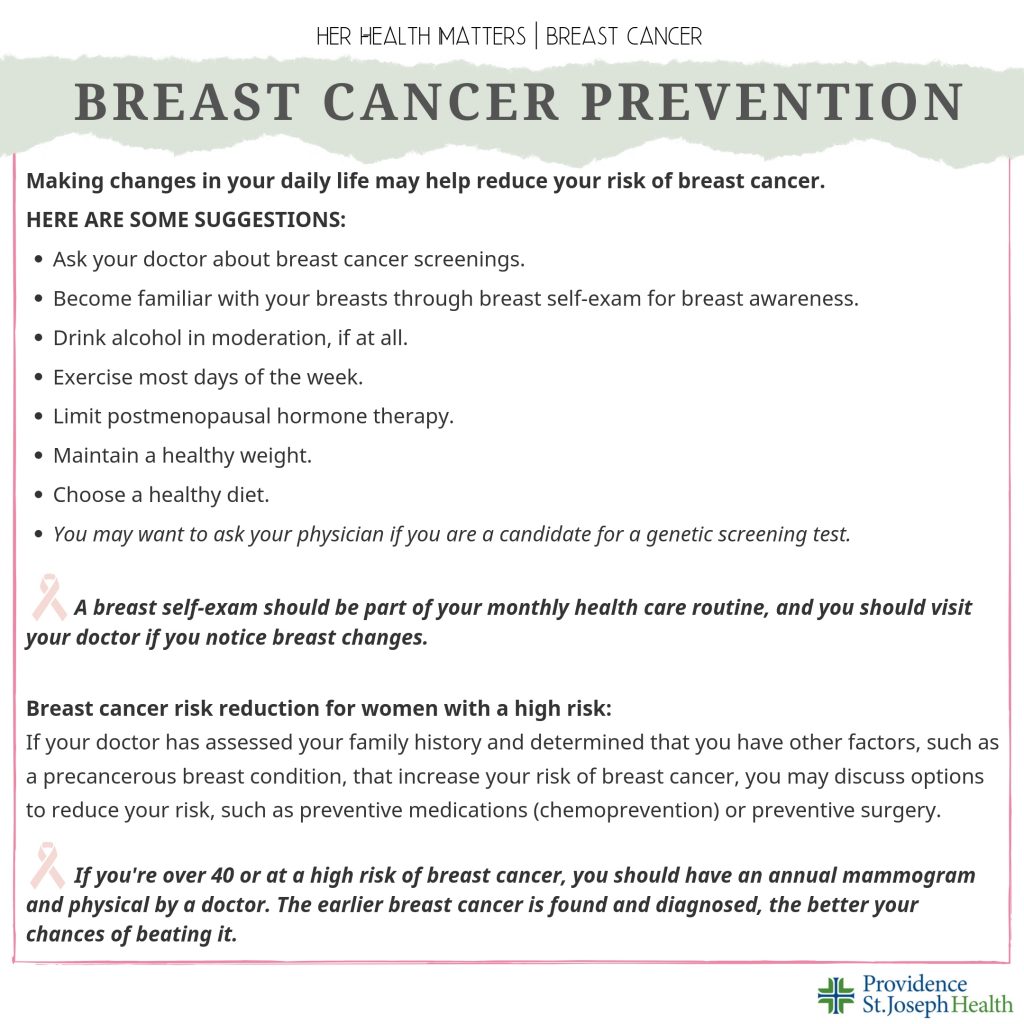
BREAST CANCER PREVENTION: Making changes in your daily life may help reduce your risk of breast cancer.
Here are some suggestions:
- Ask your doctor about breast cancer screening.
- Become familiar with your breasts through breast self-exam for breast awareness.
- Drink alcohol in moderation, if at all.
- Exercise most days of the week.
- Limit postmenopausal hormone therapy.
- Maintain a healthy weight.
- Choose a healthy diet.
- You may want to ask your physician if you are a candidate for a genetic screening test.
A breast self-exam should be part of your monthly health care routine, and you should visit your doctor if you notice breast changes.
Breast cancer risk reduction for women with a high risk:
If your doctor has assessed your family history and determined that you have other factors, such as a precancerous breast condition, that increase your risk of breast cancer, you may discuss options to reduce your risk, such as preventive medications (chemoprevention) or preventive surgery.
If you’re over 40 or at a high risk of breast cancer, you should have an annual mammogram and physical by a doctor. The earlier breast cancer is found and diagnosed, the better your chances of beating it.
About Providence St. Joseph Health
At Providence St. Joseph Health, our mission calls us to be agents of radical change for health. We’re to be a source of healing love and a beacon of hope … in the world, within each of the communities. We believe everyone deserves a chance to lead the healthiest life possible. That’s why we’re continuously innovating to create access for all and foster healthier communities. We believe that to make the greatest impact we need to leverage the assets of our organization in partnership with other organizations of goodwill that are directly addressing fundamental needs better served outside of a clinical care setting. Improving the health of our communities is fundamental and a commitment rooted deeply in our heritage and purpose.
Disclaimer: All information, content, and material of this website is for informational purposes only and are not intended to serve as a substitute for the consultation, diagnosis, and/or medical treatment of a qualified physician or healthcare provider.
MEDICAL EMERGENCY
If you have a medical emergency, call your doctor or 911 immediately.


